Supplemental oxygen - Study guides, Class notes & Summaries
Looking for the best study guides, study notes and summaries about Supplemental oxygen? On this page you'll find 9047 study documents about Supplemental oxygen.
Page 4 out of 9.047 results
Sort by
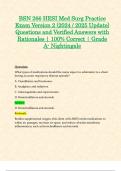
-
BSN 266 HESI Med Surg Practice Exam Version 2 (2024 / 2025 Update) Questions and Verified Answers with Rationales | 100% Correct | Grade A - Nightingale
- Exam (elaborations) • 78 pages • 2024
- Available in package deal
-
- $7.99
- 1x sold
- + learn more
BSN 266 HESI Med Surg Practice Exam Version 2 (2024 / 2025 Update) Questions and Verified Answers with Rationales | 100% Correct | Grade A - Nightingale Q: What types of medications should the nurse expect to administer to a client during an acute respiratory distress episode? A. Vasodilators and hormones. B. Analgesics and sedatives. C. Anticoagulants and expectorants. D. Bronchodilators and steroids. Answer: D. Bronchodilators and steroids. Rationale Besides supplemental oxygen, this client wi...
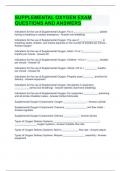
-
SUPPLEMENTAL OXYGEN EXAM QUESTIONS AND ANSWERS
- Exam (elaborations) • 4 pages • 2024
- Available in package deal
-
- $10.49
- + learn more
SUPPLEMENTAL OXYGEN EXAM QUESTIONS AND ANSWERS
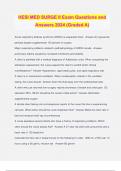
-
HESI MED SURGE II Exam Questions and Answers 2024 (Graded A)
- Exam (elaborations) • 15 pages • 2024
-
- $12.49
- 1x sold
- + learn more
HESI MED SURGE II Exam Questions and Answers 2024 (Graded A) Acute respiratory distress syndrome (ARDS) is suspected when: -Answer-A) hypoxemia persists despite supplemental 100 percent of oxygen. Major respiratory problems related to pathophysiology of ARDS include: -Answer- pulmonary edema caused by increased membrane permeability. A client is admitted with a medical diagnosis of Addisonian crisis. When completing the admission assessment, the nurse expects this client to exhibit which ...
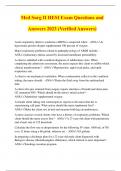
-
Med Surg II HESI Exam Questions and Answers 2023 (Verified Answers)
- Exam (elaborations) • 12 pages • 2023
- Available in package deal
-
- $10.49
- 1x sold
- + learn more
Med Surg II HESI Exam Questions and Answers 2023 (Verified Answers) Acute respiratory distress syndrome (ARDS) is suspected when: - ANSA) hypoxemia persists despite supplemental 100 percent of oxygen. Major respiratory problems related to pathophysiology of ARDS include: - ANSpulmonary edema caused by increased membrane permeability. A client is admitted with a medical diagnosis of Addisonian crisis. When completing the admission assessment, the nurse expects this client to exhibit which ...
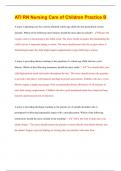
-
ATI RN Nursing Care of Children Practice B 2023 | 100% Correct Answers | Updated & Verified
- Exam (elaborations) • 18 pages • 2023
- Available in package deal
-
- $15.49
- 1x sold
- + learn more
A nurse is planning care for a newly admitted schole-age child who has generalized seizure disorder. Which of the following interventions should the nurse plan to include? - Ensure the oxygen source is functioning in the childs room: The nurse should recognize that maintaining the child's airway is important during a seizure. The nurse should ensure that the oxygen source is functioning because the child might require supplemental oxygen following a seizure. A nurse is providing dietary te...
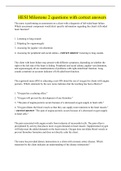
-
HESI Milestone 2 questions with correct answers
- Exam (elaborations) • 20 pages • 2023
- Available in package deal
-
- $13.99
- 2x sold
- + learn more
The nurse is performing an assessment on a client with a diagnosis of left-sided heart failure. Which assessment component would elicit specific information regarding the client's left-sided heart function? 1. Listening to lung sounds 2. Palpating for organomegaly 3. Assessing for jugular vein distention 4. Assessing for peripheral and sacral edema - correct answer Listening to lung sounds. The client with heart failure may present with different symptoms, depending on whether the righ...
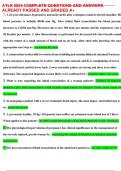
-
ATLS 2024 COMPLETE QUESTIONS AND ANSWERS ALREADY PASSED AND GRADED A+
- Exam (elaborations) • 62 pages • 2024
-
- $25.49
- 2x sold
- + learn more
1. A 22-year-old man is hypotensive and tachycardic after a shotgun wound to the left shoulder. His blood pressure is initially 80/40 mm Hg. After initial fluid resuscitation his blood pressure increases to 122/84 mm Hg. His heart rate is now 100 beats per minute and his respiratory rate is 28 breaths per minute. A tube thoracostomy is performed for decreased left chest breath sounds with the return of a small amount of blood and no air leak. After chest tube insertion, the most appropriate next...
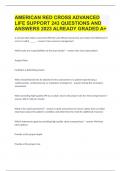
-
AMERICAN RED CROSS ADVANCED LIFE SUPPORT |243 QUESTIONS AND ANSWERS 2023 ALREADY GRADED A+
- Exam (elaborations) • 46 pages • 2023
- Available in package deal
-
- $15.49
- 1x sold
- + learn more
A concept that helps to promote effective and efficient teamwork and reduce the likelihood of errors is called _____. Crew resource management Which tasks are responsibilities of the team leader? Sets clear expectations Assigns Roles Facilitates a debriefing session When should blood tests be obtained in the assessment of a patient experiencing a cardiovascular, cerebrovascular or respiratory emergency? During the secondary assessment When providing high-quality CPR...
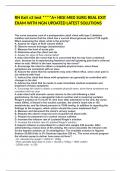
-
RN Exit v2 test ****A+ HESI MED SURG REAL EXIT EXAM WITH NGN UPDATED LATEST SOLUTIONS
- Exam (elaborations) • 31 pages • 2024
- Available in package deal
-
- $9.99
- 1x sold
- + learn more
RN Exit v2 test ****A+ HESI MED SURG REAL EXIT EXAM WITH NGN UPDATED LATEST SOLUTIONS The nurse assumes care of a postoperative adult client with type 2 diabetes mellitus and learns that the client has a current blood glucose level of 720 mg/dL. When assessing the client, what is the priority? A. Assess for signs of fluid volume deficit B. Observe wound drainage characteristics C. Measure the level of acute pain D. Determine when the client last ate A. Assess for signs of fluid volum...

-
American Red Cross ACLS Final Exam (Latest 2023/2024) Verified Answers
- Exam (elaborations) • 7 pages • 2023
-
- $15.00
- 13x sold
- + learn more
1. A patient is in cardiac arrest. The cardiac monitor shows asystole. In addition to providing continuous high-quality CPR, what is the other priority intervention for this patient? - Administering epinephrine as early as possible 2. A patient has experienced return of spontaneous circulation (ROSC) after cardiac arrest. The healthcare team is conducting a secondary assessment to determine the possible cause of the patient's cardiac arrest. Before the arrest, the patient exhibited jugul...

That summary you just bought made someone very happy. Also get paid weekly? Sell your study resources on Stuvia! Discover all about earning on Stuvia


